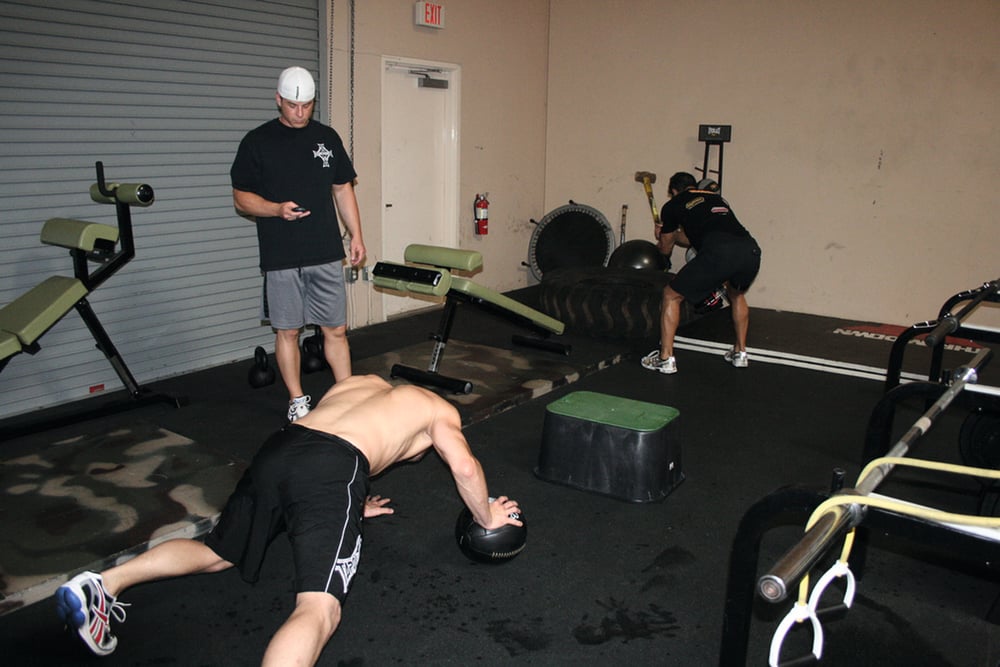
Issue 058
January 2010
Barry Gibson, strength and conditioning trainer to some of the UK’s top MMA fighters (including TUF 9 winner Ross Pearson), looks at training in groups – how to do it, and some options with equipment.
Whether you’re a coach or fighter who wants to get together with a group of training partners, it doesn’t matter; you can gain massively from this type of training. The group scenario helps with this due to the basic fact that we’re social animals by nature. The group dynamic can help athletes when motivation is a concern, as there’s nothing like a friend or coach standing by your side when you feel like quitting. Also, from the other side, there’s the competition aspect. Competition breeds champions – whether through exposure to different competitors, or ‘friendly’ competition in group training. Almost every facet of life involves group scenarios. Martial arts classes are the most relevant to this article, but group training really is a tactic that should be included in your arsenal.
This is how I organize sessions at Grapplefit in terms of indoor and outdoor situations. The simplest idea is bodyweight; everyone has their own bodyweight to contend with.
Start with basic calisthenics
Squats, push-ups, V-ups, body rows, chin-ups, etc. Then you can move on to the more advanced variations of the basics. I have never bought into the idea that bodyweight training will not get you stronger. Look at gymnasts in the Olympics – bodyweight rules! These people are strong and fit. Think about this also, manhandling another person who is fighting back (a basic aspect of combat) is easier if you can handle your own bodyweight.

Advanced options
Hindu push-ups, dive-bombers, one-leg squats, split squats, flags, plyometric push-ups, handstand push-ups, handstand walking... the list goes on and on.
A simple circuit of these exercises can be brutal and relevant to the sport. In fact, certain coaches insist on mastery of bodyweight drills before moving on to the iron. The same applies outside in the open air – there’s a major push at the moment (and I’m guilty of this too) of training outside in the open air like ‘real men’! I believe it definitely has its merits, but there is no honor in injuring yourself – in fact, it’s unprofessional to put yourself at risk. So if the weather is slightly off, don’t be silly. One slip or fall could result in a torn or pulled muscle and this can in turn lead to time off. Train hard by all means, but train smart!
As an example, let’s say you have a group of fighters raring to go – but no equipment. What to do? Try this little routine on for size:

Set out a 50m track, or if you’re in a smaller indoor setting use your mat area as your guide (so you might need to travel two or three lengths). Line the group up and get them to perform the following for time / distance:
- Bear crawl up and back
- Wheelbarrow walks with partner, changing after 50m
- Lunge walks up and back
- Dive-bomber push-ups
- 10 sprawls
- 10 burpees
- Pummel for 60 sec
- 10 jumping lunges
- Bear crawl up and back
You can chop and change that as you wish – but I’ve used this to great effect with some of my athletes. Add or subtract a few drills and do it for time appropriate to your needs.
Next, I’ll cover some more-specific partner drills to beef up your training sessions. Until then get as strong as you can with your own weight, and we will develop this by applying a bit of progression and tweaking of the drills to make them harder.
Barry Gibson is a kettlebell and fitness instructor as well as a 3rd dan black belt in judo. He is available for seminars and workshops upon request. For details or to contact him with any questions or queries, email [email protected].
...









